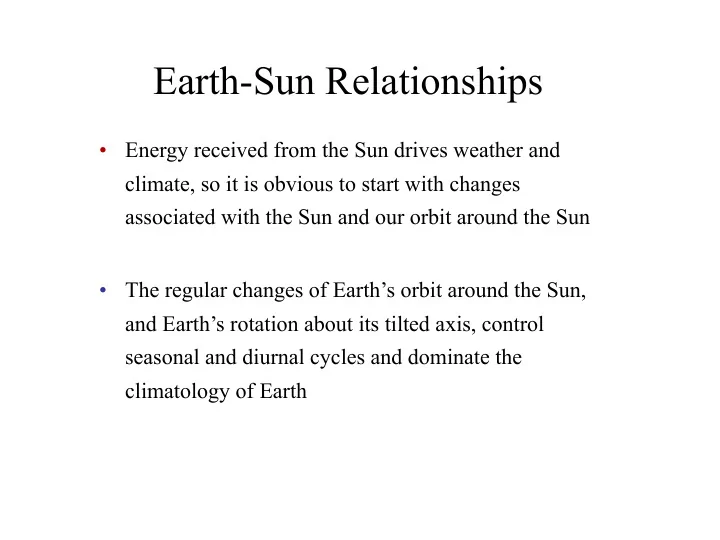

Earth-Sun Relationships • Energy received from the Sun drives weather and climate, so it is obvious to start with changes associated with the Sun and our orbit around the Sun • The regular changes of Earth’s orbit around the Sun, and Earth’s rotation about its tilted axis, control seasonal and diurnal cycles and dominate the climatology of Earth
indirect rays
distribution of incoming solar radiation Earth’s surface, and lower atmosphere, are unevenly heated low latitudes receive more energy per unit area than higher latitudes
heat budget
to understand why we have seasons, we need to look at the relations between Earth and the sun the plane of the ecliptic is the plane of Earth's orbit around the sun seasons
the planets in the solar system also orbit on or near the plane of the ecliptic (you can see that the planets are more or less lined up, instead of circling the sun at just any old angle no, this is not drawn to scale orbits
the sun's rays are pretty close to parallel to each other when they reach Earth,
so, if the Earth's axis of rotation were perpendicular to the plane of the ecliptic, the direct rays of the sun would always shine on the equator (that is, the angle of incidence at the equator would be 90 degrees) and you would always see the sun just on the horizon at the North and South Poles (that is, the angle of incidence at the Poles would be zero). if that were the case, there would be no seasons
however, the Earth's axis is not perpendicular to the plane of the ecliptic if you drew a line perpendicular to the plane of the ecliptic, the Earth's axis of rotation would be tilted, or inclined, at an angle of about 23 1 / 2 degrees with respect to the perpendicular line it is this inclination of the Earth's axis of rotation that is the reason for the seasons the earth maintains the same angle of inclination throughout its orbit seasons
geographic distribution of net radiation (annual average) low latitudes have a surplus of energy per unit area, high latitudes a deficit
seasons caused by Earth’s orientation-inclination of the axis
geographic distribution of net radiation (DJF) low latitudes have a surplus of energy per unit area, high latitudes a deficit
geographic distribution of net radiation (JJA) low latitudes have a surplus of energy per unit area, high latitudes a deficit
the spatial distribution of radiation changes through time seasons and the geometry of Earth’s orbit
changes in eccentricity ✦ eccentricity: measure of how circular or elliptical Earth’s orbit is around the Sun ✦ changes in 100,000 and 410,000 year cycles ✦ current value is 1.7% and decreasing ✦ fluctuates between 0.1% and 5.4% ✦ low values of eccentricity correlate to no change in insolation during the year (whereas now there is a difference between aphelion and perihelion)
elliptical orbit
obliquity ✦ obliquity: the inclination (tilt) of Earth’s axis to the plane of Earth’s orbit ✦ changes in a 41,000 year cycle ✦ the current value is 23.4 degrees and decreasing ✦ fluctuates between 22 degrees and 24.5 degrees. ✦ changes in obliquity will have a big effect on seasons ✦ if the obliquity reduces to zero, the seasonal cycle would vanish and pole-to-equator contrasts would sharpen, this would lead to colder periods at high latitudes
precession of the equinoxes ✦ precession: the change in the direction that the North Pole points (slow top-like rotation) ✦ changes in 19,000 to 23,000 (22,000) year cycle ✦ in 12,000 years, we will experience summer in December and winter in June ✦ this can combine with eccentricity to have a seasonal effect, for example, if the summer solstice occurs during perihelion, summers would be warmer and winters colder than today
precession of the equinoxes
orbital forcing
length of day
Length of day
daily variations in air temperature
Seasonal changes of
January
July
Hadley circulation
InterTropical Convergence Zone (ITCZ)
deserts
westerlies geostrophic wind
jet stream
jet stream
January
July
idealized pressure and precipitation
Recommend
More recommend